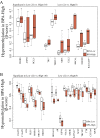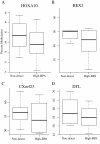Bisphenol A-associated epigenomic changes in prepubescent girls: a cross-sectional study in Gharbiah, Egypt
- PMID: 23590724
- PMCID: PMC3655072
- DOI: 10.1186/1476-069X-12-33
Bisphenol A-associated epigenomic changes in prepubescent girls: a cross-sectional study in Gharbiah, Egypt
Abstract
Background: There is now compelling evidence that epigenetic modifications link adult disease susceptibility to environmental exposures during specific life stages, including pre-pubertal development. Animal studies indicate that bisphenol A (BPA), the monomer used in epoxy resins and polycarbonate plastics, may impact health through epigenetic mechanisms, and epidemiological data associate BPA levels with metabolic disorders, behavior changes, and reproductive effects. Thus, we conducted an environmental epidemiology study of BPA exposure and CpG methylation in pre-adolescent girls from Gharbiah, Egypt hypothesizing that methylation profiles exhibit exposure-dependent trends.
Methods: Urinary concentrations of total (free plus conjugated) species of BPA in spot samples were quantified for 60 girls aged 10 to 13. Genome-wide CpG methylation was concurrently measured in bisulfite-converted saliva DNA using the Infinium HumanMethylation27 BeadChip (N = 46). CpG sites from four candidate genes were validated via quantitative bisulfite pyrosequencing.
Results: CpG methylation varied widely among girls, and higher urinary BPA concentrations were generally associated with less genomic methylation. Based on pathway analyses, genes exhibiting reduced methylation with increasing urinary BPA were involved in immune function, transport activity, metabolism, and caspase activity. In particular, hypomethylation of CpG targets on chromosome X was associated with higher urinary BPA. Using the Comparative Toxicogenomics Database, we identified a number of candidate genes in our sample that previously have been associated with BPA-related expression change.
Conclusions: These data indicate that BPA may affect human health through specific epigenomic modification of genes in relevant pathways. Thus, epigenetic epidemiology holds promise for the identification of biomarkers from previous exposures and the development of epigenetic-based diagnostic strategies.
Figures






References
-
- Barker DJ. Intrauterine programming of coronary heart disease and stroke. Acta Paediatra Suppl. 1997;423:178–182. - PubMed
-
- Barker DJP. In: Mothers, Babies, and Disease in Later Life. 2. Barker DJP, editor. Edinburgh: New York: Churchill Livingstone; 1998. Programming the baby; pp. 13–42.
-
- Wojtyla A. Application of the hypothesis of Developmental Origin of Health and Diseases (DOHaD) in epidemiological studies of women at reproductive age and pregnant women in Poland. Ann Agric Environ Med. 2011;18:355–364. - PubMed
-
- Elston CW, Ellis IO. In: The breast: systemic pathology. Volume 13. 3. Elston CW, Ellis IO, editor. Churchill Livingston: Edinburgh; 1998. Normal structure and developmental abnormalities; pp. 1–19.
-
- Russo J, Russo IH. In: The mammary gland: development, regulation, and function. Volume 1. Neville MC, Daniel CW, editor. New York: Springer; 1987. Development of the human mammary gland; pp. 67–93.
Publication types
MeSH terms
Substances
Grants and funding
LinkOut - more resources
Full Text Sources
Other Literature Sources

